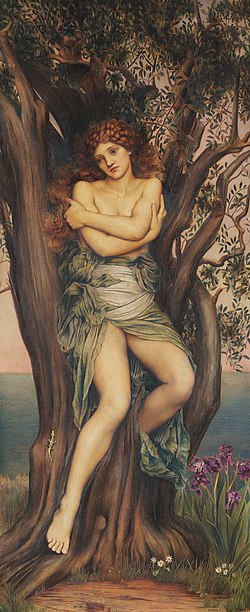Dryad
Topic: Unsolved
 From HandWiki - Reading time: 3 min
From HandWiki - Reading time: 3 min
A dryad (/ˈdraɪ.æd/; Greek: Δρυάδες, sing.: Δρυάς) is a tree nymph or tree spirit in Greek mythology. Drys (δρῦς) signifies "oak" in Greek. Dryads were originally considered the nymphs of oak trees specifically, but the term has evolved towards tree nymphs in general.[1] Often their life force was connected to the tree in which they resided and they were usually found in sacred groves of the gods.[2] They were considered to be very shy creatures except around the goddess Artemis, who was known to be a friend to most nymphs.
Types
Daphnaie
These were nymphs of the laurel trees.
Epimelides
The Maliades, Meliades or Epimelides were nymphs of apple and other fruit trees and the protectors of sheep. The Greek word melas, from which their name derives, means both apple and sheep. Hesperides, the guardians of the golden apples were regarded as this type of dryad.
Hamadryad
Dryads, like all nymphs, were supernaturally long-lived and tied to their homes, but some were a step beyond most nymphs. These were the hamadryads who were an integral part of their trees, such that if the tree died, the hamadryad associated with it also died. For these reasons, dryads and the Greek gods punished any mortal who harmed trees without first propitiating the tree-nymphs. (associated with Oak trees)
Meliae
The dryads of the ash tree were called the Meliae.[1] The Meliae sisters tended the infant Zeus in Rhea's Cretan cave. Gaea gave birth to the Meliae after being made fertile by the blood of castrated Uranus. The Caryatids were associated with walnut trees.[1]
Names
Some of the individual dryads or hamadryads are:
- Atlanteia and Phoebe, two of the many wives or concubines of Danaus[3]
- Chrysopeleia[4]
- Dryope[5]
- Erato[6]
- Eurydice
- Tithorea[7]
In popular culture
This article appears to contain trivial, minor, or unrelated references to popular culture. (May 2021) |
- Keats addresses the nightingale as "light-winged Dryad of the trees", in his "Ode to a Nightingale" .
- In the poetry of Donald Davidson they illustrate the themes of tradition and the importance of the past to the present.[8]
- In Lev Grossman's The Magicians Trilogy, the character Julia becomes a dryad after having had her shade removed during her rape at the hands of Reynard the Fox. Her transformation accelerates when she visits Fillory in the company of the novel's other principals, and is complete when she and Quentin Coldwater visit Fillory's underworld.[9]
- The fantasy novels of Thomas Burnett Swann frequently feature dryads, along with other mythological creatures, usually endangered by the advent of more "advanced" civilisations. Swann's story "The Dryad-tree" is set in contemporary Florida and features a woman's reaction to the knowledge that her new husband's garden contains a tree possessed by a jealous dryad. The story was adapted as a short film in 2017.[10]
See also
- Oreads, a related mountain nymph
- Ghillie Dhu, a similar Scottish spirit
- Kodama, a similar Japanese spirit
- Green spirit, a similar spirit found in Myanmar and other Buddhist countries
- Elf, a similar mythical creature associated with nature
- Querquetulanae, Roman nymphs of the oak
- Rådande, a similar Swedish spirit
- Salabhanjika, a similar Indian spirit
- Mavka, a similar Ukrainian spirit
References
Citations
- ↑ 1.0 1.1 1.2 Graves, ch. 86.2; p. 289
- ↑ "Nymphs | Theoi Greek Mythology". https://www.theoi.com/greek-mythology/nymphs.html.
- ↑ Apollodorus, 2.1.5
- ↑ Tzetzes on Lycophron, 480
- ↑ Ovid, Metamorphoses 9.330 ff; Antoninus Liberalis, 32
- ↑ Pausanias, 8.4.2
- ↑ Pausanias, 10.32.9
- ↑ Martha E. Cook (1979). "Dryads and Flappers". The Southern Literary Journal (University of North Carolina Press) 12 (1): 18–26.
- ↑ Lev Grossman, The Magician King. New York: Viking, 2011. pp.343-357. ISBN:978067002231-1
- ↑ "The Dryad Tree (2017) - IMDb". IMDb. https://www.imdb.com/title/tt4082936/. Retrieved 25 August 2018.
Bibliography
- Graves, Robert (1955). Greek Myths. London: Penguin. ISBN 0-14-001026-2. https://archive.org/details/greekmythsvolume00robe.
- Burkert, Walter, 1985. Greek Religion (Cambridge: Harvard University Press).
External links
- Greek Mythology Link: Nymphs.
- Hans Christian Andersen, "The Dryad", 1868 (e-text)
- Andersen, H. C.; Craigie (transl.) "The Dryad" Fairy tales and other stories London; Toronto: Oxford University Press. 1914
- Tim Hoke, "The Dryad", 2002 (e-text; strong language)
 |
 KSF
KSF

